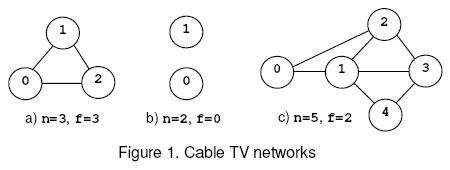Description
The interconnection of the relays in a cable TV network is bi-directional. The network is connected if there is at least one interconnection path between each pair of relays present in the network. Otherwise the network is disconnected. An empty network or a network with a single relay is considered connected. The safety factor f of a network with n relays is:
1. n, if the net remains connected regardless the number of relays removed from the net.
2. The minimal number of relays that disconnect the network when removed.

For example, consider the nets from figure 1, where the circles mark the relays and the solid lines correspond to interconnection cables. The network (a) is connected regardless the number of relays that are removed and, according to rule (1), f=n=3. The network (b) is disconnected when 0 relays are removed, hence f=0 by rule (2). The network (c) is disconnected when the relays 1 and 2 or 1 and 3 are removed. The safety factor is 2.
1. n, if the net remains connected regardless the number of relays removed from the net.
2. The minimal number of relays that disconnect the network when removed.

For example, consider the nets from figure 1, where the circles mark the relays and the solid lines correspond to interconnection cables. The network (a) is connected regardless the number of relays that are removed and, according to rule (1), f=n=3. The network (b) is disconnected when 0 relays are removed, hence f=0 by rule (2). The network (c) is disconnected when the relays 1 and 2 or 1 and 3 are removed. The safety factor is 2.
Input
Write a program that reads several data sets from the standard input and computes the safety factor for the cable networks encoded by the data sets. Each data set starts with two integers: 0<=n<=50,the number of relays in the net, and m, the number of cables in the net. Follow m data pairs (u,v), u < v, where u and v are relay identifiers (integers in the range 0..n-1). The pair (u,v) designates the cable that interconnects the relays u and v. The pairs may occur in any order.Except the (u,v) pairs, which do not contain white spaces, white spaces can occur freely in input. Input data terminate with an end of file and are correct.
Output
For each data set, the program prints on the standard output, from the beginning of a line, the safety factor of the encoded net.
Sample Input
0 0 1 0 3 3 (0,1) (0,2) (1,2) 2 0 5 7 (0,1) (0,2) (1,3) (1,2) (1,4) (2,3) (3,4)
Sample Output
0 1 3 0 2
idea:
At first,这道题和最小割十分相似,可是我们要将割点转换为割边,将一个点拆成入点和出点
然后将入点向出点连一条边权为1的边,表示这个点删掉的代价为1,每一条无向边(a,b)需要将a的出点连向b的入点,反之亦然
这样删掉点就相当于删掉a的入点到a的出点这一条边,完成了点边转化
每一次,我们需要枚举源点和汇点,取最小值,源点要求是一个出点,汇点是一个入点,求最小割即保留源点和汇点的情况下使原图断开的最大花费
输出答案即可,上代码
#include<iostream>
#include<cstring>
#include<cstdio>
#include<algorithm>
#include<queue>
#define rep(i,a,b) for(int i=a;i<=b;i++)
#define MAXN 30002
using namespace std;
queue<int> Q;
int vals[MAXN],tot,t,n,m,ii,ij,to[MAXN],nxt[MAXN],val[MAXN],fir[MAXN],cur[MAXN],dep[MAXN];
void read(){
char ch=getchar();
while(ch!='(') ch=getchar();
ch=getchar(); ii=0;
while('0'<=ch && ch<='9') ii=(ii<<1)+(ii<<3)+ch-'0',ch=getchar();
ch=getchar(); ij=0;
while('0'<=ch && ch<='9') ij=(ij<<1)+(ij<<3)+ch-'0',ch=getchar();
}
void ade(int u,int v,int z){
//cout<<u<<" "<<v<<" "<<z<<endl;
val[++tot]=z;
to[tot]=v;
nxt[tot]=fir[u];
fir[u]=tot;
}
bool bfs(int s,int t){
memset(dep,0,sizeof(dep));
dep[s]=1; while(!Q.empty()) Q.pop();
Q.push(s);
while(!Q.empty()){
int x=Q.front(); Q.pop();
for(int k=fir[x];k!=-1;k=nxt[k]){
if(val[k] && !dep[to[k]]){
dep[to[k]]=dep[x]+1;
Q.push(to[k]);
}
}
}
if(dep[t]) return 1;
return 0;
}
int dfs(int x,int dis,int t){
if(x==t) return dis;
for(int k=cur[x];k!=-1;k=nxt[k]){
cur[x]=k;
if(dep[to[k]]==dep[x]+1 && val[k]){
int z=dfs(to[k],min(dis,val[k]),t);
if(z){
val[k]-=z; val[k^1]+=z;
return z;
}
}
}
return 0;
}
int Dinic(int s,int t){
int res=0,d;
while(bfs(s,t)){
rep(i,0,n*2-1) cur[i]=fir[i];
d=dfs(s,99999999,t);
while(d){
res+=d;
d=dfs(s,99999999,t);
}
}
return res;
}
int main(){
while(~scanf("%d%d",&n,&m)){
memset(fir,-1,sizeof(fir)); tot=-1;
rep(i,1,m){
read();
if(ii==ij) continue;
ade(ii+n,ij,99999999); ade(ij,ii+n,0);
ade(ij+n,ii,99999999); ade(ii,ij+n,0);
}
rep(u,0,n-1) ade(u,u+n,1),ade(u+n,u,0);
if(n==0 || m<n-1){
puts("0");
continue;
}
if(n==1){
puts("1");
continue;
}
rep(i,0,tot) vals[i]=val[i];
int ans=99999999;
rep(i,n,n+n-2){
rep(j,i+1,n+n-1)
{
rep(k,0,tot) val[k]=vals[k];
ans=min(ans,Dinic(i,j-n));
}
}
if(ans==99999999) ans=n;
printf("%d
",ans);
}
return 0;
}